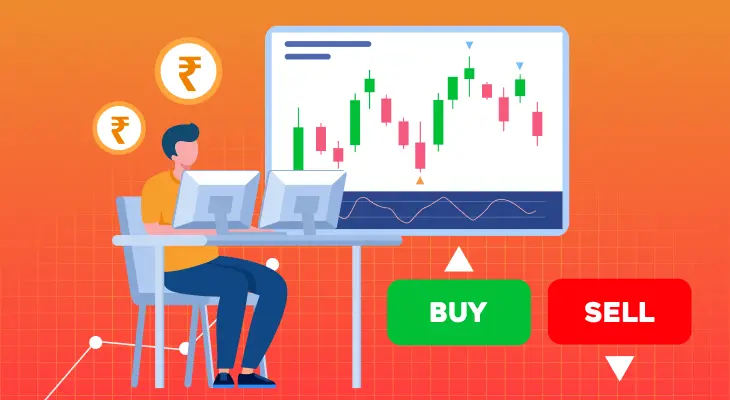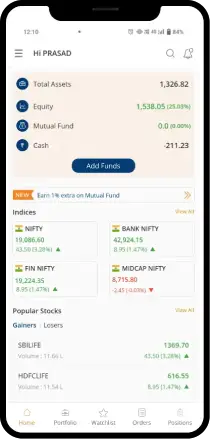
Table of content
What is Sensex and How is it Calculated?
What is Sensex?
The term, SENSEX was coined in 1989 by a stock market analyst, Deepak Mohoni, and is the combination of the words ‘sensitive’ and ‘index’. With a base value of 100, Sensex is currently trading at < VAR > levels, growing at an absolute rate of < VAR >%. Sensex is a weighted average combination of 30 of the biggest and most actively traded companies listed on the Bombay Stock Exchange.
Sensex has had remarkable expansion ever since it first opened in the 1990s, particularly after 2000. For instance, information technology firms contributed to the index's first crossing of the 6000 mark in 2002. From that moment on, Sensex grew from strength to strength, closing at 39,056.65 on April 2, 2019, breaking beyond 39,000 points for the first time. The significant rise in India's Gross Domestic Product (GDP) since the turn of the century is responsible for this growth curve.
The 30 companies which make up the index is selected by the S&P BSE Index Committee based on the following criteria:
- Company must be listed on the Bombay Stock Exchange.
- Company must be large-cap with market capitalisation of more than Rs 25,000 crores
- Company must be actively traded i.e. liquid.
30 Sensex Companies
| S No. | Company Name | Weight in Sensex |
|---|---|---|
| 1 | Reliance Industries Ltd. | 11.99% |
| 2 | HDFC Bank | 11.84% |
| 3 | Infosys Ltd. | 9.06% |
| 4 | HDFC | 8.30% |
| 5 | ICICI BANK | 7.37% |
| 6 | TCS | 5.76% |
| 7 | KOTAK BANK | 4.88% |
| 8 | HINDUNILVR | 3.75% |
| 9 | ITC | 3.49% |
| 10 | AXISBANK | 3.35% |
| 11 | L&T | 3.13% |
| 12 | BAJFINANCE | 2.63% |
| 13 | SBIN | 2.59% |
| 14 | BHARTIARTL | 2.31% |
| 15 | ASIAN PAINTS | 1.97% |
| 16 | HCLTECH | 1.89% |
| 17 | MARUTI | 1.72% |
| 18 | M&M | 1.48% |
| 19 | ULTRACEMCO | 1.40% |
| 20 | SUNPHARMA | 1.16% |
| 21 | TECHM | 1.11% |
| 22 | TITAN | 1.11% |
| 23 | NESTLEIND | 1.07% |
| 24 | BAJAJFINSV | 1.04% |
| 25 | INDUSINDBK | 1.03% |
| 26 | POWERGRID | 1.03% |
| 27 | TATASTEEL | 1.01% |
| 28 | NTPC | 0.94% |
| 29 | BAJAJ AUTO | 0.86% |
| 30 | ONGC | 0.73% |
How does the Sensex work?
The Sensex, short for the Sensitive Index, is a stock market index representing 30 of the largest and most financially sound companies listed on the Bombay Stock Exchange (BSE). These companies are selected based on factors like market capitalisation, liquidity, and industry representation. The Sensex uses a free-float market capitalisation method, which considers the market value of a company’s shares that are available for trading.
How is the Sensex calculated?
To guarantee that it accurately reflects the state of the stock market , BSE periodically adjusts the share composition of the Sensex. The weighted technique of market capitalization was initially used to compute the index. But this computation approach has been updated since 2003 and now incorporates a free-float capitalization method.
This free-float technique is an alternative to the market-capitalization method in which the index is calculated using the number of shares available for sale under a corporation rather than the number of outstanding shares. Thus, restricted stocks (those held by corporate insiders) that are not for sale are not included in this strategy.
A company's market capitalization (outstanding shares X share price) is multiplied by free-float factor to obtain its free-float capitalization. The ratio of issued shares to outstanding shares is this factor. The index level consistently represents the free-float value of the 30 listed companies that make up the Sensex, relative to a base period, in accordance with this free-float capitalization technique.
How To Invest In The Sensex?
Investing in the Sensex can be done in several ways:
-
Direct Investment in Sensex Companies:
You can buy shares of the 30 companies that constitute the Sensex through a brokerage account. Remember, this requires careful selection and monitoring of individual stocks. -
Index Funds:
These are mutual funds that aim to replicate the performance of the Sensex by investing in the same 30 companies in the same proportion. It offers a simple way to invest in the entire index without picking individual stocks. -
Exchange-Traded Funds (ETFs):
ETFs are similar to index funds but are traded on the stock exchange like individual stocks. Investing in a Sensex ETF allows you to buy and sell shares throughout the trading day at market prices. -
Systematic Investment Plan (SIP):
You can also invest in index funds through SIPs, which allows you to invest a fixed amount regularly, reducing the risk of market volatility.
An online trading investing platform like m.Stock can make it very convenient for you to invest in the Sensex. With m.Stock, you can effortlessly buy and sell shares of the 30 companies that constitute the Sensex, access real-time market data, and analyse performance with advanced tools. The platform also supports investments in index funds and ETFs that track the Sensex, offering a diversified and simplified approach to investing. Additionally, features like systematic investment plans (SIPs), user-friendly interfaces, and secure transactions make m.Stock a reliable choice for both beginners and experienced investors looking to capitalise on the growth of the Indian stock market.
Milestones of Sensex India
The Sensex has witnessed several significant milestones since its inception:
1986:
The Sensex was first compiled and published.1990:
Crossed the 1,000 mark.2006:
Reached 10,000 points for the first time.2007:
Surpassed the 20,000 mark.2015:
Hit the 30,000 level for the first time.2019:
Touched 40,000 points, a new record.2021:
Post-Covid, surpassed the 50,000 mark. It continued its bull run and hit 60,000 later the same year. showcasing the growth and investor confidence over the years.2023:
Another milestone reached after breaching the mark of 70,000 points.2024:
Covers 10,000 points in record time and crosses 80,000.
Major Plunges in Sensex Stocks
The Sensex has also experienced major declines, reflecting market volatility and economic crises:
1992:
The Harshad Mehta scam led to a significant drop.2008:
Global financial crisis saw the Sensex plummet by over 50%.2011:
The European debt crisis and US credit downgrade caused significant market drops.2020:
The COVID-19 pandemic led to one of the steepest falls in the history of Sensex.
However, even after these declines, the Sensex has usually bounced back stronger than before. Since 2006 till date, the Sensex has surged from 10,000 to 80,000 points clearly demonstrating its resilience and ability to generate long-term gains for its investors.
Significant drops in Sensex
-
Between 2008 and 2009, a stock market crash and a decline in the intraday trading of the Dow Jones industrial average contributed to a serious crisis in the global economy. The stock market in India was also negatively impacted by this catastrophe, suffering its largest point loss ever on January 21st, 2008, losing 1408 points, leading to trading being halted for an hour the following day.
Sensex continually declined from January through November 2008, creating concern throughout the market. The market reached its lowest point in the past ten years in October 2008, closing at 8509.56 points. - In 2009, the Satyam fraud caused the index to decline by roughly 750 points, upsetting the market.
- In 2020, when the lockdown was announced to contain the pandemic, Sensex fell from 41,000 levels in February 2020 to 27,500 levels in April 2020.
Despite the ups and downs, Sensex has maintained its status as the top stock market index in the country over the past 30 years. Since tracking and investing in individual stocks can be exceedingly challenging for investors, Sensex gives an easy access to the top, most traded and liquid stocks in the country. Trade in Sensex stocks at zero brokerage for life with m.Stock. Open an account now!






